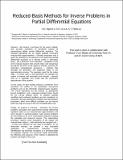| dc.contributor.author | Nguyen, C.N. | |
| dc.contributor.author | Liu, Guirong | |
| dc.contributor.author | Patera, Anthony T. | |
| dc.date.accessioned | 2003-12-14T23:05:30Z | |
| dc.date.available | 2003-12-14T23:05:30Z | |
| dc.date.issued | 2004-01 | |
| dc.identifier.uri | http://hdl.handle.net/1721.1/3891 | |
| dc.description.abstract | We present a technique for the rapid, reliable, and accurate evaluation of functional outputs of parametrized elliptic partial differential equations. The essential ingredients are (i) rapidly globally convergent reduced-basis approximations – Galerkin projection onto a space WN spanned by the solutions of the governing partial differential equations at N selected points in parameter space; (ii) a posteriori error estimation - relaxations of the error-residual equation that provide sharp and inexpensive bounds for the error in the output of interest; and (iii) off-line/online computational procedures – methods that decouple the generation and projection stages of the approximation process. The operation count for the online stage – in which, given a new parameter, we calculate the output of interest and associated error bounds – depends only on N (typically very small) and the parametric dependencies of the problem.
In this study, we first develop rigorous a posteriori error estimators for (affine in the parameter) noncoercive problems such as the Helmholtz (reduced-wave) equation. The critical ingredients are the residual, an appropriate bound conditioner, and a piecewise-constant lower bound for the inf-sup stability factor. In addition, globally nonaffine (and nonlinear) problems are also considered: in particular, through appropriate sampling and interpolation procedures, these more difficult problems can be reduced (with very high accuracy) to the more tractable affine case.
Finally, we propose a real-time - procedure for inverse problems associated with parametrized partial differential equations based on our reduced-basis approximations and error bounds. In general practice, many inverse problems are formulated as an error minimization statement relating the calculated and measured outputs. This optimization procedure requires many evaluations of the output: the reduced-basis method --- with extremely low marginal cost --- is thus very efficient for this class of problems. As an illustrative example, we consider a very important application in nondestructive evaluation: crack identification (by harmonic excitation) in a laminated plate of composite material. The numerical results demonstrate the efficiency and accuracy of the method in detecting the location and length of the crack. | en |
| dc.description.sponsorship | Singapore-MIT Alliance (SMA) | en |
| dc.format.extent | 15952 bytes | |
| dc.format.mimetype | application/pdf | |
| dc.language.iso | en_US | |
| dc.relation.ispartofseries | High Performance Computation for Engineered Systems (HPCES); | |
| dc.subject | reduced-basis approximations | en |
| dc.subject | a posteriori error estimation | en |
| dc.subject | off-line/online computational procedures | en |
| dc.subject | parametrized elliptic partial differential equations | en |
| dc.title | Reduced-Basis Methods for Inverse Problems in Partial Differential Equations | en |
| dc.type | Article | en |
